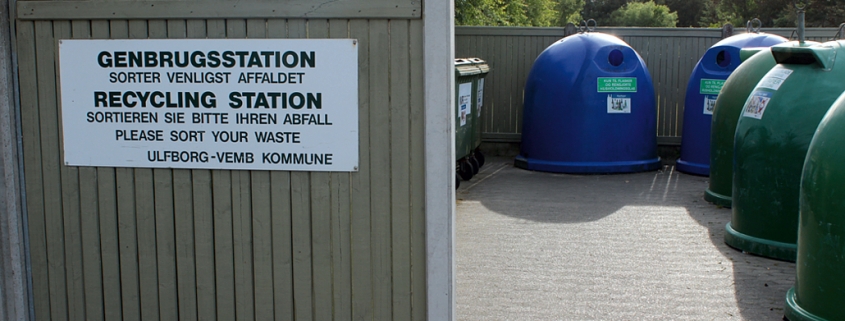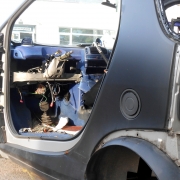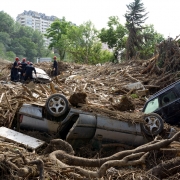Bornholm Turning Away From Incineration: Forming the Spearhead for Denmark?
“Bornholm will become the world’s first industrialized community to achieve 100 percent waste recycling and reuse”, news agency BusinessWire emphasized at the end of January. Within 13 years, citizens, businesses and tourists on the Danish island want to improve waste handling, sorting and treatment, so that by 2032 all regionally produced waste will be reused or recycled.
As Bornholm has a fully developed infrastructure and an isolated small population, the island appears to be the perfect object to realize the “Bornholm showing the way” vision of BOFA, the local municipal waste company. Additionally, it is a perfect time now, as the island’s waste incineration plant will be amortized in 2032, and the local government has to decide whether to allocate funds for updating the existing plant, to build a new facility or to initiate an innovative comprehensive scheme handling and treating waste as a resource that can be recirculated. BOFA wishes to make Bornholm the first region in Europe without waste incineration.
The idea growing nationwide
Bornholm may be an “isolated” island, but the idea to reduce or even replace incineration by other waste treatment methods has been growing in Denmark nationwide. The country wants to carry out a change from what Zero Waste Europe called a “passion for burning garbage”. At the end of 2005, 29 waste-to-energy facilities treated roughly a quarter of the total waste generated in Denmark. In 2010 the country’s municipal solid waste was incinerated by 55 percent, recycled by 42 percent and landfilled by three percent, according to Eurostat. And in 2016 Dansk Affaldsforening, the communal interest group for the waste sector, indicated a recycling rate of 69 percent, an energy recovery rate of 27 percent and a landfilling quota of four percent. In the same year, the number of combustible waste imports was expected to rise up to 400,000 tons annually.
In 2011, a governmental paper “Denmark without waste” had reported that a total of 61 percent of Denmark’s waste was recycled, 29 percent incinerated and six percent landfilled. “This means that far too many of the valuable materials today end in waste incineration plants or at landfills. Therefore, more waste must be recycled, and the quality of the recycled material must be improved,” the report commented. In her foreword to “Denmark without waste. Recycle more – incinerate less”, Danish Minister for the Environment Ida Auken balanced in November 2013: “Over recent decades in Denmark, we have been incinerating almost 80 percent of our household waste. Even though this has made an important contribution to green energy production, materials and resources have been lost which could otherwise have been recycled.” And she added: “Now, we are going to change this.”
820,000 tons less waste incinerated
Put in concrete terms, this meant a “conversion” of the Danish waste sector: “The Government will modernize organization of the incineration sector to ensure that waste incineration is at the most efficient plants and that the waste sector supports recycling,” the official paper underlined. A new Resources Strategy for Waste Management consisted of six fields of “initiatives” including more recycling of materials from households and the service sector, more recycling of materials from waste electronic equipment and shredder waste, a switch from waste incineration to bio-gasification and recycling, better exploitation of important nutrients such as phosphorus, improved quality in recycling construction and demolition waste and a Green conversion opening new commercial opportunities.
The expected changes included an increase in recycling from 1.4 million tons in 2012 to 2.6 million tons in 2022 and a decline of incineration from 2.8 million tons in 2012 to 2.3 million tons in 2022. “With these initiatives, a total of 820,000 tons less waste will be incinerated in 2022 than would otherwise have been the case,” the paper proclaimed.
Strengthened conditions
The Danish municipalities are primarily responsible for the waste area, especially for household waste. Most incineration plants are owned by municipal or inter-municipal companies. The municipal cooperation ensures the establishment of the necessary incineration capacity and of the principles of proximity and self-sufficiency. The waste-to-energy facilities are operated by nonprofit companies, based on a cost coverage principle. With regard to recycling, in many cases capacity is ensured by the municipality establishing agreements with private recycling companies. Most types of waste that are recycled are processed abroad, but there are many Danish enterprises – private and public – which separate and pre-treat the waste before it is exported. Irrespective of whether it comes from households or businesses, waste is primarily collected and transported by private companies. Recyclable commercial waste separated at source is subject to market conditions.
In September 2016, the Danish Ministry of Energy, Supply and Climate published a strategy named “Supply for the Future” that strengthened the conditions for waste incineration: It envisaged the authority for companies to decide the place for treatment of combustible waste instead of assigning it to the municipality. Municipalities collecting household waste are accordingly asked to search a competitive and cost-effective tender for incineration. And waste incineration plants operated and owned by municipalities have to be transformed into municipally-owned companies and driven on market terms. The aforementioned case study additionally proposes fiscal incentives around incineration of plastics by considering a differentiated tax rate between plastic separated and unseparated material for incineration.
28 waste incineration plants still running
Notwithstanding the purpose to reduce energy recovery, a new waste-to-energy unit for 200,000 tons per year was commissioned in Roskilde in 2013, I/S Nordforbraending installed a new unit for its waste-to-energy facility with 90,000 tons per year in 2016, and Amager Bakke, a waste-to-energy plant with a capacity of 2 x 280,000 tons of waste annually that was built on green field in Copenhagen, commenced its operations in 2016. Amager Bakke was heavily criticized by Zero Waste Europe: With a 500 million Euro figure it is “the most expensive of its kind”, showed several technical childhood diseases, has a far too high processing capacity and is – in one word – a costly mistake for the city of Copenhagen. The organization prophesizes: “With less waste around to burn moving forward, Copenhagen’s new, shiny furnace will have much more downtime, leading to profit losses and monetary burdens for citizens in years to come.”
Maybe. But there are still 28 waste incineration plants running in Denmark, whereof 22 are dedicated waste incineration plants that primarily convert household and industrial waste to energy. Four are multi-fuel plants that both incinerate household and industrial waste as well as biomass and natural gas. The remaining two are for incinerating hazardous waste, public-private partnership State of Green gave account. And more than 20 percent of all district heating and five percent of electricity is delivered by waste incineration plants.
Alternatives for future waste management
Their future has been analyzed by the TopWaste-Report, a result of a Danish strategic research project and published by the Technical University of Denmark, Department of Management Engineering. The researchers looked for alternatives for future waste management in Denmark and thought about combustible waste and related imports. At the moment – the paper summed up – the imports of such sort of waste towards Denmark uses the existing incineration over-capacities and substitutes the use of fossil fuels. But “in the long term, imports of combustible waste towards Denmark would require an investment in over-capacity and will depend on the evolution of electricity and district heating markets, the availability of waste and the willingness of countries to pay to get rid of it.“ The question at planning for the future of Denmark’s incineration capacity arises whether the country with its extensive district heating networks and very high thermal efficiency should count on waste imports or on national resources. “On the other hand, the system can be locked in to large investments which might negatively impact recycling and/or the economy of incineration plants.”
Investment in incineration is not offered
There are a lot of challenges for energy recovery in Denmark at present, Klaus Fafner, Projekt Manager at engineering consultation agency Rambol, certified in late 2017 at the IX. International Investment Business Forum Renewable Energy and Energy Efficient Modernization of Industry. Along with technical challenges and the “appetite to risk”, he mentioned high investment costs, long development timescales, deterring risk-reward profiles, cost-driving “immature” supply chains and complex stakeholder arrangements. And he referred to a political environment characterized by unavailable support for heat networks, an unstable national policy and insufficient leverage of local planning policy. In fact, “Denmark without waste II. A waste prevention strategy,” following the first paper already in April 2015, nearly did not lose a word about incineration and may be seen as an indicator to a new political course. Likewise, the Resource and Waste Management Plan for the City of Copenhagen in 2018 got along without reference to incineration. Nevertheless, the investment agency Copenhagen Capacity wrote, that “new supply strategy enhances opportunities for foreign companies in the Danish waste management sector”. Invest in Denmark, incorporated into the Ministry of Foreign Affairs, counts on bioenergy industry, “the biggest contributor to Denmark’s green energy transition – offering lucrative opportunities for international companies that are looking to invest”. And adds: “For international players, the investment opportunities (in a strong bioenergy cluster) are substantial.” Investment in incineration is not offered.
Photo: O. Kürth
(GR 22019, Page 25)









